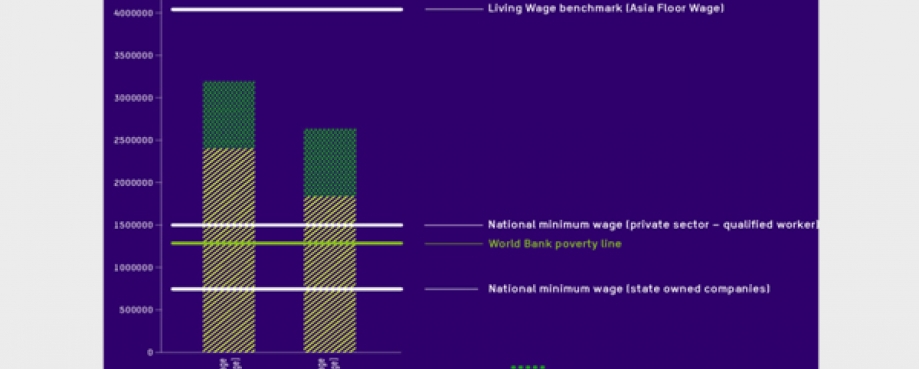
The issue of a living wage is going up the corporate responsibility agenda. Last month, I blogged during Living Wage week about its importance to address in-work poverty. Here I want to discuss the drivers and blockers for a living wage in global supply chains and describe some promising new initiatives that could get things moving.
A commitment to a living wage has been incorporated into the better codes of labour practice – ETI Base Code, SA8000 – since the late 1990s. 27,000 members of one member organisation alone - Sedex - use the ETI code in addition to the direct members of ETI. Yet for a decade, the element stating that ‘Living wages are paid’ has merely been debated, not implemented (with a few exceptions such as Marks & Spencer in garments and Finlays in fresh produce), with companies citing a daunting set of ‘blockers’ that outweigh the ‘drivers’.
Living wage indicators
BLOCKERSDRIVERS
Reliance on governments to set a
minium wage that is a minimum wage
Living wage is part of many corporate policies
Reliance on audits that benchmark only to the minium wageReputational risk from campaigns and exposes
Living wage calculations are complex and there is a lack of agreement on levels
Factories and farms experience skill shortages and production lost to unrest Weaknesses in wage bargaining, especially for women workersCollapse of Rana Plaza focuses investors on supply chain risks Weaknesses in workplace inspection by governmentsUN Guiding Principles challenge companies to respect human rights Price pressure and short-term relationaships in the supply chainMandatory reporting in pipeline on non-financial issues Lack of buy-in by suppliers and producers
Five years ago two innovations came along to help remove some of the blockers: the Asia Floor Wage campaign, and wage ladder tools.
Asia Floor Wage - a credible methodology for calculating a living wage
This was an initiative of theAsia Floor Wage Alliancein 2009 - a coalition of workers’ organisations in the continent where 80% of global garment production occurs. With support from allies in Europe and the USA, the coalition developed a credible methodology for calculating a wage level based on a ‘family basket’ derived from calorie needs and Consumer Price Indices, assuming a wage needs to support two adults and two children . The method enables comparison across countries and figures are updated annually.
Wage ladders - illustrate both the problem and ‘what good looks like’
The innovation of wage ladders – graphics that show wage levels in relation to wage and poverty benchmarks - came from multi-stakeholder dialogue in the garment sector around 2006. Oxfam and Ethical Tea Partnership then borrowed the idea for our study Understanding wages in the tea industry. The wage ladders developed for us by Ergon clearly illustrate that wages of tea pluckers in Malawi and Assam fall well below the poverty line despite meeting the legal minimum.
Oxfam used the ladder tool in another study undertaken with Unilever. This backed up testimony from workers we interviewed, that wages were well short of a Living Wage, despite easily exceeding the minimum (p.70).
Simplified version of a wage ladder from Oxfam’s report Labour Rights in Unilever’s Supply Chain: From Compliance towards Good Practice.
And in our recent Poverty Footprint study of fresh produce with IPL, we used the AFW methodology to calculate that wages of flower workers around Nairobi could be doubled for an additional 5p on a £4 bunch of roses.
The World Banana Forum also used wage ladders to promote understanding of sustainability challenges in the banana industry and develop a plan with social dialogue at its heart.
Onwards and upwards
The Asia Floor Wage provides concrete figures from a grassroots workers’ movement, while wage ladders communicate the issue to a business audience. Oxfam’s experience is that taken together, these have helped companies better understand our concerns about poverty wages and to make commitments to address them.
For instance, a new collaboration is bringing together the tea industry, NGOs and trade unions with support from European companies, certifiers and development agencies. We presented this recently with Ethical Tea Partnership at an international European Conference on Living Wages in Berlin, at which other initiatives were announced, including one by the world's second-largest clothing retailer, H&M. Starting with two factories in Bangladesh and one in Cambodia, to which it will pay higher wholesale prices, the Swedish company has committed to achieve a ‘fair living wage’ for 850,000 workers in 750 factories by 2018.
Other relevant initiatives and resources include the new Fairwear report, ETI’s Living Wage round-up, the FLA’s Fair Wage Dimensions, Impactt’s Benefits for Business and Workers report, campaigns by Clean Clothes Campaign, Labour behind the Label and War on Want, and more widely the Play Fair protocol and the Bangladesh Accord.
2013 has been a year for cautious optimism that the poverty wages highlighted by campaign reports for more than a decade are finally moving up corporate agendas and starting to result in meaningful action. We hope the innovations and initiatives highlighted here help more companies to embrace this agenda.
